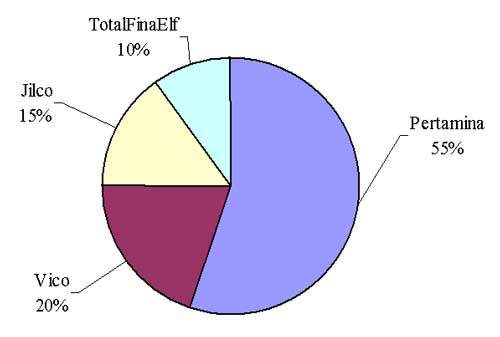
The Bontang LNG plant, operated by PT Badak in East Kalimantan, Bontang, Indonesia, processes the gas from a huge reserve discovered in 1972 at Badak Field, East Kalimantan, as well as the Samberah, Nilam and Mutiara fields.
Coming into operation in 1977, the plant has grown to become one of the largest LNG plants in the world, with eight process trains (A-H – H was completed in June 1999 by a IKPT / Kellogg and BKE / AJ Lucas joint operation) and the capacity to process 21.64 million tons a year. To date, over 227 million tons of gas has been supplied by the plant to Japan, Korea and Taiwan.
The processing trains at Bontang were modernised in 2004 with automation and other equipment (such as gas chromatographs, analytical instruments, automation systems, new cabling and so on) in order to improve the LNG plant’s productivity.
At that time due to declining gas reserves from the traditional supply fields the Bontang facility took over from Arun as the main gas supply centre from Indonesia. Bontang has also fallen foul of supply problems.
EFFICIENCY DRIVE
The plant operator, PT Badak NTL Co., has initiated a programme of reliability enhancement to eliminate weaknesses in the plant and where possible to avoid them in advance to facilitate a continuous increase in the plant’s efficiency and reliability.
The plant’s modernisation and expansion was the first major infrastructure project announced by the post-Suharto Indonesian administration. Badak’s output was increased to 24.59 million tons a year by 2004, but declined soon after due to supply problems from production fields.
The Chiyoda Corporation and its subsidiary PT Chiyoda International Indonesia (CII) carried out the engineering in partnership with Siemens. The project was funded by a $1.1bn loan from a syndicate led by the Bank of Taiwan with members also including Mitsubishi Corp., Chase Manhattan, Banque Indonesia, Fuji Bank, Long Term Credit Bank and Tokai Bank.
MODERNISATION OF THE LNG TRAINS IN BONTANG
The 15-year-old trains A-D were being modernised by Chiyoda, which constructed trains E, F and G. The company replaced the instrument and plant control system and integrated it with the current DCS system. The work was completed in September 2002.
Chiyoda chose Siemens as a partner for fitting analytical components because of a proven track record of cooperation between the two companies during previous projects, all being carried through to successful conclusion.
The equipment being supplied includes eight analyser shelters, each with 12 gas chromatographs from the Advance Maxum series, and four infrared analysers.
There are now 12 AAI advance optichrom process gas chromatographs from previous deliveries together with the 12 new Advance Maxum units.
Australian cable manufacturer Olex Cables was awarded a contract to supply over 800km of Dekoron instrumentation cable for the control room as part of the $50m retrofit.
Part of its contract also includes the supply of specialised products, where Olex Cables customised its Dekoron instrumentation cable to meet new fire regulations. Olex steel-wire armoured the Dekoron instrumentation cable to improve physical durability and rodent protection.
NINTH TRAIN EXPANSION
The state-owned company Pertamina, which operates the Badak plant, announced in June 2005 its intent to draw up a basic plan for a ninth train (I). Chiyoda was expected to be awarded the contract for the design. The construction contract, worth several million yen, will be opened for international tender following the completion of the basic plan.
This ninth train is the latest in a long line of expansion programmes for the plant. In 1980, trains C and D were built to meet demand from Japanese buyers. In 1988 LPG extraction facilities were completed.
Refrigerated LPG production by the plant is dedicated to Japanese export. Demand from Japan, Taiwan and Korea continued to grow, leading to train E being constructed in 1987-89, and train F followed in 1991-93. Train G was completed in 1997 and train H was completed in 1999 and the plant became the biggest in the world.
So far this project to construct train I has not been started and the dual train Tanghu liquefaction plant (Indonesia’s third LNG facility) is due to start up in 2008.
LONG TERM PROBLEMS
In 2005 Bontang was producing about 20mtpa of LNG. It began experiencing LNG shortfalls in 2004, causing the GOI (Government of Indonesia) to ask its Japanese buyers to cancel 41 LNG cargoes for 2005.
Maintaining Bontang’s production has its own set of challenges:
- Gas supply problems: the three gas providers (Total, VICO and Unocal (since purchased by Chevron)) have experienced underproduction or inconsistent production due to maintenance, accident or low field performance
- Lack of investment incentives: Bontang’s LNG sales contracts have no penalties for non-performance; i.e. the producers bear no additional cost to the buyers for failing to meet contract obligations – questions over who is responsible for maintenance and repair at the aging PT Badak facility, as well as potential future charges by its operator Pertamina, have slowed investment in the facility
- Fertiliser plants: despite LNG shortfalls, the GOI diverts gas from Bontang’s producers so that Pertamina can sell subsidised gas to a national fertiliser plant group and two small Japanese-owned plants
There is light at the end of the tunnel however as in September 2007 Chevron decided to increase production from the Kutei Basin gas fields off East Kalimantan by making additional investment. This will give Bontang LNG plant a chance to shore up its dwindling production.
Bontang might now be able to provide up to 10 million tons a year of LNG supply to Japan beyond 2011, rather than the expected three million tons.

